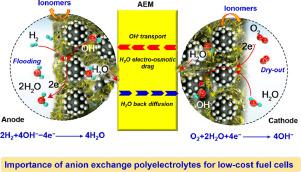Progress in Polymer Science ( IF 26.0 ) Pub Date : 2020-12-29 , DOI: 10.1016/j.progpolymsci.2020.101345 Nanjun Chen , Young Moo Lee

|
Anion exchange membrane fuel cells (AEMFCs) have attracted great interest as a low-cost fuel cell technology for clean energy conversion and utilization for the future. AEMFCs have been considered the most promising succedaneum to proton exchange membrane fuel cells (PEMFCs) for addressing the cost issues associated with PEMFCs due to utilizing non-platinum group metals as electrocatalysts under alkaline conditions (such as Ag, Ni, and Co). Herein, we focus on a critical topic of AEMFCs—-anion-exchange polyelectrolytes (AEPs)—which are essential materials for low-cost AEMFCs. Specifically, AEPs have been used as anion-exchange membranes (AEMs) and binders (or ionomers) in AEMFCs. Years of study have allowed AEMFCs to recently achieve unprecedented progress, specifically in terms of power density and durability. These properties are comparable to or higher thanPEMFCs due to the recent development of high performance AEPs. Currently, most AEPs focused on the application of AEMs, and the importance of ionomer research has not been widely recognized. Moreover, a comprehensive review involving a systematic performance comparison of the state-of-the-art AEMs and ionomers is still lacking, making future research on AEMFCs unclear. This review systematically and comprehensively summarizes the development of AEPs and highlights the importance of cationic species and polymer backbone structures on durability with an emphasis on the importance of ionomer research. We further describe the differences between AEMs and ionomers by comparing the advantages and disadvantages of the state-of-the-art AEMs and ionomers to accurately guide future research on AEMFCs. We cover synthetic methods, degradation mechanisms, strategies to enhance performance, water transport behaviors, structure design criteria, and new challenges for AEMs and ionomers. This review is expected to expand further understanding of AEMs and ionomers and provide a future direction for designing AEMs and ionomers for future AEMFCs.
中文翻译:

用于膜和离聚物的阴离子交换聚电解质
阴离子交换膜燃料电池(AEMFC)作为一种低成本燃料电池技术已经引起了极大的兴趣,该技术未来将用于清洁能源的转换和利用。由于在碱性条件下利用非铂族金属作为电催化剂(例如Ag,Ni和Co),因此AEMFC被认为是解决质子交换膜燃料电池相关成本问题的最有前景的质子交换膜燃料电池(PEMFC)的替代品。在此,我们重点讨论AEMFC的一个关键主题-阴离子交换聚电解质(AEP),这是低成本AEMFC的重要材料。具体而言,AEP已被用作阴离子交换膜(AEM)和粘合剂(或离聚物)在AEMFC中。多年的研究使AEMFC最近取得了空前的进步,特别是在功率密度和耐用性方面。由于高性能AEP的最新发展,这些性能与PEMFC相当或更高。目前,大多数AEP都集中在AEM的应用上,离聚物研究的重要性尚未得到广泛认可。此外,仍缺乏对最新的AEM和离聚物进行系统性能比较的全面综述,这使得对AEMFC的未来研究不清楚。这篇综述系统地和全面地总结了AEP的发展,并强调了阳离子种类和聚合物骨架结构对耐久性的重要性,并着重研究了离聚物的重要性。我们通过比较最新型AEM和离聚物的优缺点来准确地指导AEMFC的未来研究,从而进一步描述AEM和离聚物之间的区别。我们涵盖了合成方法,降解机理,增强性能的策略,水传输行为,结构设计标准以及AEM和离聚物的新挑战。预期这次审查将进一步加深对AEM和离聚物的理解,并为将来的AEMFC设计AEM和离聚物提供未来的方向。











































 京公网安备 11010802027423号
京公网安备 11010802027423号